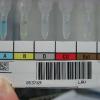Reputation Activity
-
 Dansket got a reaction from Marianne in Separate Blood Bank Armbands
Dansket got a reaction from Marianne in Separate Blood Bank Armbands
John,
I used the same system, Biologics, Inc, out of Utah. The beauty of this system was that all samples collected by the phlebotomists were labeled with this system. Secondly, the specimen container labels could only be made at the bedside and that the information on the label was generated from a plastic tag (attached to the patient) that was embossed with patient information. This was a mechanical system that has now been mimicked by electronic systems that generate specimen container label from a barcode on the patient wristband.
With this type of system, mechanical or electronic, there is no need for a secondary blood bank identification band.
-
 Dansket got a reaction from galvania in Blood group discrepancy Ortho vision analyzer
Dansket got a reaction from galvania in Blood group discrepancy Ortho vision analyzer
This approach becomes very problematic when dual-population (mixed-field agglutination) is observed in ABO/Rh typing in a highly computerized transfusion service. Do you segregate these patients to a manual system on paper or other type of non-standard handling or do you mainstream the patient in the computer system?
I prefer to mainstream these situations so that staff are not forced to rarely used manual systems. One of the main tenets that I taught staff was 'to record what you see, not what you think it should be'. So I designed the computer system to make this possible, without exception. For example, if you see dual-population in gel test, that is what you enter into the computer (there are results mnemonics 4+m versus 4+ to differentiate dual-population from uncomplicated agglutination).
The computer is configured to reflex additional tests to the sample which prompt user with additional information and questions. If there is a blood type on file (done prior to transfusion) and there are recent ABO/Rh non-identical transfusions, computer will calculate blood type as Rh Positive when Rh Negative red cells are transfused to an Rh Positive recipient that resulted in the observation of dual-population in the anti-D tube of gel card of a post-transfusion blood sample. That's one heck of a run-on sentence.
The same thing will occur if a non-group O recipient is transfused with group O red cells.
Your computer system may/may not be able to do this.
-
 Dansket got a reaction from Malcolm Needs in Blood group discrepancy Ortho vision analyzer
Dansket got a reaction from Malcolm Needs in Blood group discrepancy Ortho vision analyzer
This approach becomes very problematic when dual-population (mixed-field agglutination) is observed in ABO/Rh typing in a highly computerized transfusion service. Do you segregate these patients to a manual system on paper or other type of non-standard handling or do you mainstream the patient in the computer system?
I prefer to mainstream these situations so that staff are not forced to rarely used manual systems. One of the main tenets that I taught staff was 'to record what you see, not what you think it should be'. So I designed the computer system to make this possible, without exception. For example, if you see dual-population in gel test, that is what you enter into the computer (there are results mnemonics 4+m versus 4+ to differentiate dual-population from uncomplicated agglutination).
The computer is configured to reflex additional tests to the sample which prompt user with additional information and questions. If there is a blood type on file (done prior to transfusion) and there are recent ABO/Rh non-identical transfusions, computer will calculate blood type as Rh Positive when Rh Negative red cells are transfused to an Rh Positive recipient that resulted in the observation of dual-population in the anti-D tube of gel card of a post-transfusion blood sample. That's one heck of a run-on sentence.
The same thing will occur if a non-group O recipient is transfused with group O red cells.
Your computer system may/may not be able to do this.
-
 Dansket got a reaction from John C. Staley in Separate Blood Bank Armbands
Dansket got a reaction from John C. Staley in Separate Blood Bank Armbands
John,
I used the same system, Biologics, Inc, out of Utah. The beauty of this system was that all samples collected by the phlebotomists were labeled with this system. Secondly, the specimen container labels could only be made at the bedside and that the information on the label was generated from a plastic tag (attached to the patient) that was embossed with patient information. This was a mechanical system that has now been mimicked by electronic systems that generate specimen container label from a barcode on the patient wristband.
With this type of system, mechanical or electronic, there is no need for a secondary blood bank identification band.
-
 Dansket reacted to SMILLER in Separate Blood Bank Armbands
Dansket reacted to SMILLER in Separate Blood Bank Armbands
We use them. No plans to drop them. There are just too many problems relying on the chart-label armbands for patient ID.
Scott
-
 Dansket got a reaction from MOBB in ABO Retype
Dansket got a reaction from MOBB in ABO Retype
Were you cited with a deficiency? If not, I would ignore inspector's musings.
I dislike the term "retype", it seems ambiguous to me. The last time I looked at CAP standards they required that the patient's ABO be confirmed or verified, but did not prescribe a testing protocol/method.
-
 Dansket got a reaction from NicolePCanada in ABO Retype
Dansket got a reaction from NicolePCanada in ABO Retype
To address this question of safety, I would like to see hard data from the AABB community as to the frequency of events where an ABO discrepancy was detected in the second ABO determination that was not detected in the first ABO determination. More importantly, did the detection of an ABO discrepancy (missed by the first ABO determination) prevent the transfusion of ABO incompatible red blood cells?
My responses above assume that the ABO discrepancy was demonstrable by repeat testing of the first blood sample.
-
 Dansket got a reaction from SMILLER in ABO Retype
Dansket got a reaction from SMILLER in ABO Retype
To address this question of safety, I would like to see hard data from the AABB community as to the frequency of events where an ABO discrepancy was detected in the second ABO determination that was not detected in the first ABO determination. More importantly, did the detection of an ABO discrepancy (missed by the first ABO determination) prevent the transfusion of ABO incompatible red blood cells?
My responses above assume that the ABO discrepancy was demonstrable by repeat testing of the first blood sample.
-
 Dansket got a reaction from John C. Staley in ABO Retype
Dansket got a reaction from John C. Staley in ABO Retype
To address this question of safety, I would like to see hard data from the AABB community as to the frequency of events where an ABO discrepancy was detected in the second ABO determination that was not detected in the first ABO determination. More importantly, did the detection of an ABO discrepancy (missed by the first ABO determination) prevent the transfusion of ABO incompatible red blood cells?
My responses above assume that the ABO discrepancy was demonstrable by repeat testing of the first blood sample.
-
 Dansket got a reaction from exlimey in ABO Retype
Dansket got a reaction from exlimey in ABO Retype
To address this question of safety, I would like to see hard data from the AABB community as to the frequency of events where an ABO discrepancy was detected in the second ABO determination that was not detected in the first ABO determination. More importantly, did the detection of an ABO discrepancy (missed by the first ABO determination) prevent the transfusion of ABO incompatible red blood cells?
My responses above assume that the ABO discrepancy was demonstrable by repeat testing of the first blood sample.
-
 Dansket got a reaction from tcoyle in ABO Retype
Dansket got a reaction from tcoyle in ABO Retype
You are correct that both CAP and AABB agree as to how the initial ABO/Rh determination be done.
However they do not agree as to how the ABO/Rh verification testing is done!
TRM.40550 refers to the initial determination of a patient's ABO/Rh typing on a current blood sample. There is another CAP standard for "ABO Confirmation" as part of the "Computer Crossmatch" requirements.
See TRM.40670 ABO Group and Rh(D) Type Verification Phase II. "The recipient's ABO group and Rh(D) type has been verified by repeat testing of the same sample, a different sample, or agreement with a historical type in the laboratory's records." This checklist requirement does not state the method of repeat testing nor does it refer to TRM.40550.
-
 Dansket got a reaction from TreeMoss in ABO Retype
Dansket got a reaction from TreeMoss in ABO Retype
You are correct that both CAP and AABB agree as to how the initial ABO/Rh determination be done.
However they do not agree as to how the ABO/Rh verification testing is done!
TRM.40550 refers to the initial determination of a patient's ABO/Rh typing on a current blood sample. There is another CAP standard for "ABO Confirmation" as part of the "Computer Crossmatch" requirements.
See TRM.40670 ABO Group and Rh(D) Type Verification Phase II. "The recipient's ABO group and Rh(D) type has been verified by repeat testing of the same sample, a different sample, or agreement with a historical type in the laboratory's records." This checklist requirement does not state the method of repeat testing nor does it refer to TRM.40550.
-
 Dansket got a reaction from John C. Staley in ABO Retype
Dansket got a reaction from John C. Staley in ABO Retype
You are correct that both CAP and AABB agree as to how the initial ABO/Rh determination be done.
However they do not agree as to how the ABO/Rh verification testing is done!
TRM.40550 refers to the initial determination of a patient's ABO/Rh typing on a current blood sample. There is another CAP standard for "ABO Confirmation" as part of the "Computer Crossmatch" requirements.
See TRM.40670 ABO Group and Rh(D) Type Verification Phase II. "The recipient's ABO group and Rh(D) type has been verified by repeat testing of the same sample, a different sample, or agreement with a historical type in the laboratory's records." This checklist requirement does not state the method of repeat testing nor does it refer to TRM.40550.
-
 Dansket got a reaction from John C. Staley in ABO Retype
Dansket got a reaction from John C. Staley in ABO Retype
Were you cited with a deficiency? If not, I would ignore inspector's musings.
I dislike the term "retype", it seems ambiguous to me. The last time I looked at CAP standards they required that the patient's ABO be confirmed or verified, but did not prescribe a testing protocol/method.
-
 Dansket reacted to Patty in Positive Antibody Screen due to Rhig
Dansket reacted to Patty in Positive Antibody Screen due to Rhig
We check for a 3 month RHIG history (probably could be longer but we chose 3 months). If the ABSC is + we do a mini panel (Ortho panel has cells marked with * - Immucor has cells with brackets; if negative rule out significant antibodies other than D. We then call it Anti-D RHIG. This Anti-D only requires a full AHG crossmatch while it is demonstrating. If patient returns ABSC Neg we can go back to electronic XM.
-
 Dansket reacted to AMcCord in Transport or Storage?
Dansket reacted to AMcCord in Transport or Storage?
Agree. I have also heard this straight from the FDA at a question and answer session at AABB. The answer was quite explicit - storage.
-
 Dansket got a reaction from AMcCord in IgG vs AHG
Dansket got a reaction from AMcCord in IgG vs AHG
Stopped using Polyspecific AHG in lieu of Monospecific Anti-IgG for antibody screen/crossmatch tube testing in 1980 and of course Anti-IgG Gel testing since 1996. No occurrence since then that would cause me to reverse those decisions.
-
 Dansket got a reaction from exlimey in IgG vs AHG
Dansket got a reaction from exlimey in IgG vs AHG
Stopped using Polyspecific AHG in lieu of Monospecific Anti-IgG for antibody screen/crossmatch tube testing in 1980 and of course Anti-IgG Gel testing since 1996. No occurrence since then that would cause me to reverse those decisions.
-
 Dansket got a reaction from Malcolm Needs in IgG vs AHG
Dansket got a reaction from Malcolm Needs in IgG vs AHG
Stopped using Polyspecific AHG in lieu of Monospecific Anti-IgG for antibody screen/crossmatch tube testing in 1980 and of course Anti-IgG Gel testing since 1996. No occurrence since then that would cause me to reverse those decisions.
-
 Dansket reacted to TreeMoss in Cold Agglutinin incubation phases
Dansket reacted to TreeMoss in Cold Agglutinin incubation phases
We used to use that same procedure when we were doing open heart surgeries and the patient was on bypass. If our antibody screen was positive at 4 degrees, we would test at 10, 15, and 20 degrees - maybe even 30 degrees if the room temperature incubation was positive. Whatever the thermal range was, we would then do an antibody ID (who cares) and titer at that temperature. We would also include a test at 4 degrees using a 20% suspension of the patient cells to see if there was agglutination after 30 minutes. We in the blood bank were very happy when new surgeons were brought in who no longer wanted that testing -- working on beating hearts and doing mini valve replacements, etc. has helped us immensely.
-
 Dansket reacted to nziegler in Analyzer Printouts
Dansket reacted to nziegler in Analyzer Printouts
You must be able to retrieve original instrument data for at least 2 years. For something like a small Clinitek, the result tape is the only thing you would have to prove what the instrument originally gave - as results can be modified once they cross the interface. Most bigger analyzers have a way to store patient data electronically.
-
 Dansket got a reaction from mcgouc in RH TYPE ON CORD BLOOD SAMPLES
Dansket got a reaction from mcgouc in RH TYPE ON CORD BLOOD SAMPLES
Our SOP requires that newborns, who test negative with anti-D by immediate-spin test, must be tested for Weak D using anti-D antiserum formulated for Weak D testing. If the Weak D Control is agglutinated, we report Rh type of the newborn as "Indeterminate" and "RhIG indicated" for the mother if the mother is Rh negative.
-
 Dansket got a reaction from Patty in RH TYPE ON CORD BLOOD SAMPLES
Dansket got a reaction from Patty in RH TYPE ON CORD BLOOD SAMPLES
Our SOP requires that newborns, who test negative with anti-D by immediate-spin test, must be tested for Weak D using anti-D antiserum formulated for Weak D testing. If the Weak D Control is agglutinated, we report Rh type of the newborn as "Indeterminate" and "RhIG indicated" for the mother if the mother is Rh negative.
-
 Dansket got a reaction from R1R2 in RH TYPE ON CORD BLOOD SAMPLES
Dansket got a reaction from R1R2 in RH TYPE ON CORD BLOOD SAMPLES
Our SOP requires that newborns, who test negative with anti-D by immediate-spin test, must be tested for Weak D using anti-D antiserum formulated for Weak D testing. If the Weak D Control is agglutinated, we report Rh type of the newborn as "Indeterminate" and "RhIG indicated" for the mother if the mother is Rh negative.
-
 Dansket got a reaction from ANORRIS in RH TYPE ON CORD BLOOD SAMPLES
Dansket got a reaction from ANORRIS in RH TYPE ON CORD BLOOD SAMPLES
Our SOP requires that newborns, who test negative with anti-D by immediate-spin test, must be tested for Weak D using anti-D antiserum formulated for Weak D testing. If the Weak D Control is agglutinated, we report Rh type of the newborn as "Indeterminate" and "RhIG indicated" for the mother if the mother is Rh negative.









